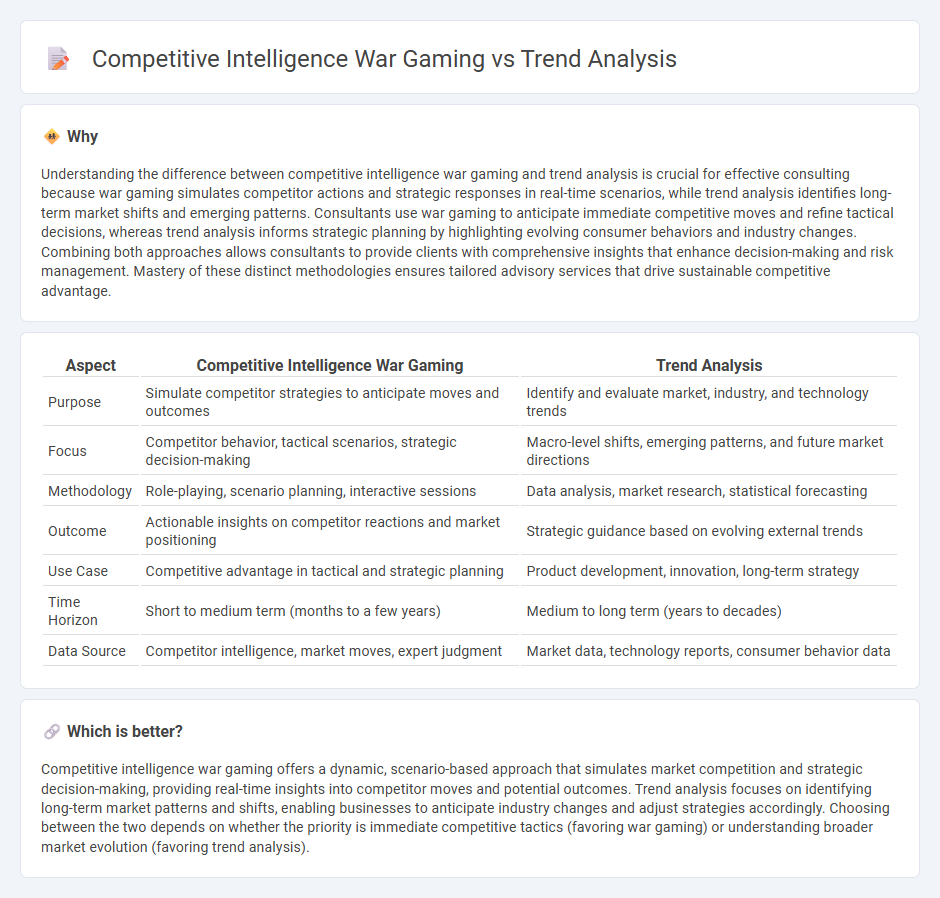
Consulting in competitive intelligence leverages war gaming to simulate market rival scenarios, enabling firms to anticipate competitor moves and strategic responses with heightened accuracy. Trend analysis offers predictive insights by examining historical data and current market shifts to forecast industry developments and consumer behavior. Explore more to understand how these methodologies can drive strategic advantage in dynamic business landscapes.
Why it is important
Understanding the difference between competitive intelligence war gaming and trend analysis is crucial for effective consulting because war gaming simulates competitor actions and strategic responses in real-time scenarios, while trend analysis identifies long-term market shifts and emerging patterns. Consultants use war gaming to anticipate immediate competitive moves and refine tactical decisions, whereas trend analysis informs strategic planning by highlighting evolving consumer behaviors and industry changes. Combining both approaches allows consultants to provide clients with comprehensive insights that enhance decision-making and risk management. Mastery of these distinct methodologies ensures tailored advisory services that drive sustainable competitive advantage.
Comparison Table
| Aspect | Competitive Intelligence War Gaming | Trend Analysis |
|---|---|---|
| Purpose | Simulate competitor strategies to anticipate moves and outcomes | Identify and evaluate market, industry, and technology trends |
| Focus | Competitor behavior, tactical scenarios, strategic decision-making | Macro-level shifts, emerging patterns, and future market directions |
| Methodology | Role-playing, scenario planning, interactive sessions | Data analysis, market research, statistical forecasting |
| Outcome | Actionable insights on competitor reactions and market positioning | Strategic guidance based on evolving external trends |
| Use Case | Competitive advantage in tactical and strategic planning | Product development, innovation, long-term strategy |
| Time Horizon | Short to medium term (months to a few years) | Medium to long term (years to decades) |
| Data Source | Competitor intelligence, market moves, expert judgment | Market data, technology reports, consumer behavior data |
Which is better?
Competitive intelligence war gaming offers a dynamic, scenario-based approach that simulates market competition and strategic decision-making, providing real-time insights into competitor moves and potential outcomes. Trend analysis focuses on identifying long-term market patterns and shifts, enabling businesses to anticipate industry changes and adjust strategies accordingly. Choosing between the two depends on whether the priority is immediate competitive tactics (favoring war gaming) or understanding broader market evolution (favoring trend analysis).
Connection
Competitive intelligence war gaming simulates market scenarios to anticipate competitor moves and strategic shifts, providing actionable insights for businesses. Trend analysis identifies emerging patterns and industry changes, which feed into the war gaming process to enhance scenario accuracy and relevance. Together, they enable consultants to develop robust strategies by integrating predictive market behavior with data-driven foresight.
Key Terms
Data Pattern Recognition
Trend analysis focuses on identifying emerging patterns and shifts within data sets over time, enabling businesses to anticipate market movements and consumer behavior. Competitive intelligence war gaming simulates competitor actions and market scenarios to predict outcomes and formulate strategic responses. Explore how mastering data pattern recognition enhances both methodologies for superior decision-making.
Benchmarking
Trend analysis identifies industry shifts by tracking emerging patterns, crucial for proactive business strategies. Competitive intelligence war gaming simulates market scenarios to benchmark company performance against rivals, revealing strategic advantages and weaknesses. Explore deeper insights into integrating benchmarking with these tools for enhanced decision-making.
Scenario Simulation
Trend analysis identifies evolving market patterns by examining historical and current data to forecast future developments. Competitive intelligence war gaming involves scenario simulation where companies recreate competitive battles, exploring strategic responses under different market conditions to anticipate rivals' moves. Discover how scenario simulation enhances strategic planning in competitive intelligence war gaming.
Source and External Links
Trend Analysis: Definitions, Types of Trends and FAQs - Trend analysis is a technique that uses financial data to recognize market patterns and forecast future performance, identifying types of trends such as uptrends, downtrends, and horizontal trends to support business and investment decisions.
What is Trend Analysis? Definition, Examples and Methods - Trend analysis involves comparing historical data points over time using methods like descriptive, comparative, predictive, and technical analysis to detect meaningful patterns and apply them to business strategy.
What Is Trend Analysis? Types & Best Practices - Trend analysis is a statistical approach using techniques like time-series and regression analysis to identify data patterns over time for predicting market changes and guiding decisions in areas such as inventory and marketing.
 dowidth.com
dowidth.com